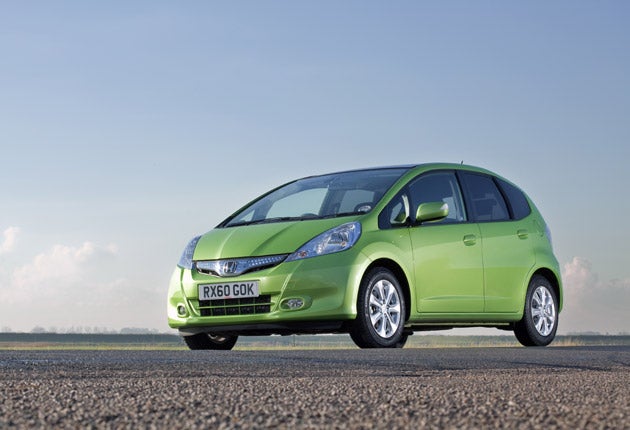Honda Jazz Hybrid
It sounds perfect for the urban family, but you can have too much of a good thing

It ought to be the perfect car for the urban family.
A supermini shaped like an MPV and moved by a hybrid powertrain. Plenty of space for five, low official CO2 figures and the promise of genuinely cheap, low-pollution running on congested streets. It's easy to park, a versatile load-carrier, and it fits easily through gaps.
Sounds ideal, yes? But what's odd about the Honda Jazz Hybrid is that no other car-maker makes anything similar. Is the Jazz the only supermini in step? Or is the idea actually not quite so clever in practice?
Hondas with this particular combination of 1.3-litre engine, continuously variable automatic transmission, and a slender electric motor between the two, already exist as the larger, Toyota Prius-like Insight and the CR-Z sports coupé, both of them based on Jazz underpinnings. A distinct hybrid identity having been established, now it's the turn of the mainstream Jazz. It's the cheapest of the three, with prices starting at £15,995, but that is still dearer than high-economy diesel rivals with which it will be compared.
The numbers look promising, though, even if the top speed, the fuel economy and the CO2 figure are all slightly worse than in the more aerodynamic Insight. The engine is a lower-power version of the regular Jazz 1,339cc unit, producing 88bhp here, while the motor manages 14bhp but a lot of torque, and the combination comfortably exceeds a normal Jazz 1.3's outputs. The official CO2 score is 104g/km, so the Jazz Hybrid doesn't quite sneak under the free road tax threshold nor does it escape London's congestion charge. But £10 a year for road tax is hardly burdensome and the first year is free.
Most UK-market Jazz models are made in Swindon but the Hybrid comes from Japan. This year's models have revised suspension and steering settings to counter criticisms of a bumpy ride and a stiff steering feel, and the Hybrid's are different again to allow for the extra weight of the motor over the front wheels and a slim battery pack under the boot floor. It's a clever bit of packaging, with the Jazz's usual versatility unchanged.
To drive, the Hybrid is as you would expect an automatic Jazz to be – especially now that the regular Jazz auto has itself regained the previous-generation's continuously variable gearbox in place of the jerky, surge-prone and much-disliked i-Shift "robotised manual". The electric motor acts as the petrol engine's starter, so starting is instant, quiet and smooth. The engine stops when the car does, apart from when power is needed to keep the battery charged, and in certain circumstances the Jazz can run, briefly and slowly, on electric alone. That's when it makes the most sense. Nothing can beat a hybrid for economy in an urban setting, except a pure electric car which could never match a hybrid's all-round usability.
On the open road, with the electric motor boosting the engine's efforts, things are less clear, given the different ways of driving this Jazz; trying to keep the instrument lighting green (best economy) or letting it fade through turquoise to blue (profligacy). There's an "Econ", but if you're in a hurry you'll find the turgidity tedious.
On a 140-mile, mainly-motorway drive the Jazz averaged 43.3mpg, which means the Jazz Hybrid is probably a better bet than an economy-optimised diesel supermini if you do much town driving. As for the revised suspension and steering, the ride comfort is fine and most of the time the steering feels smooth and responsive.
An earlier encounter with the same Jazz Hybrid, during the snow and ice, perfectly revealed what is wrong with the electric power assistance (EPAS) that is fast becoming the new-car norm. EPAS, if well programmed, can synthesise a fair approximation of the true road feel experienced in a conventional system, but seemingly it can't mimic the low forces of feedback generated on a slippery road. So, in snow it feels completely numb, and quite scary because you don't know what the front wheels are doing. We opted to leave the Honda in the drive and took our conventionally power-steered 2001 Toyota instead.
The Rivals
Fiat 500 TwinAir: from £10,865
Punchy, 875cc, two-cylinder turbo engine. Great "official" economy, less good in reality because you enjoy it too much (85bhp, 95g/km).
Ford Fiesta 1.6 TDCi Econetic 5dr: £14,495
Various eco-tricks make it very frugal, but it's still fun to drive. Makes strong financial sense (95bhp, 98g/km).
Volkswagen Polo 1.2 TDI BlueMotion 5dr: £15,840
Diesel engine has three cylinders. Ultra-low CO2 emissions, feels odd to drive but the process engages you (75bhp, 91g/km).
Join our commenting forum
Join thought-provoking conversations, follow other Independent readers and see their replies
Comments
Bookmark popover
Removed from bookmarks